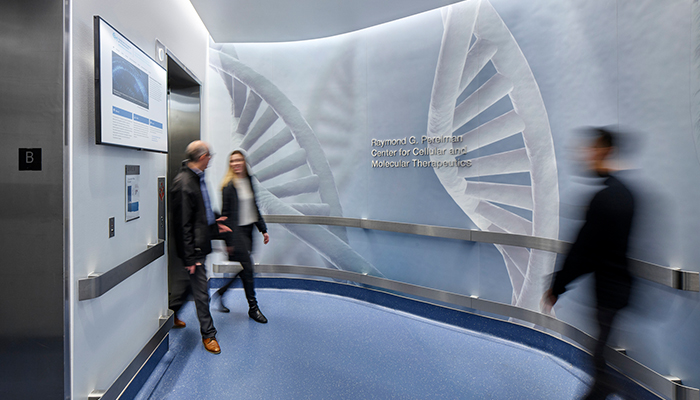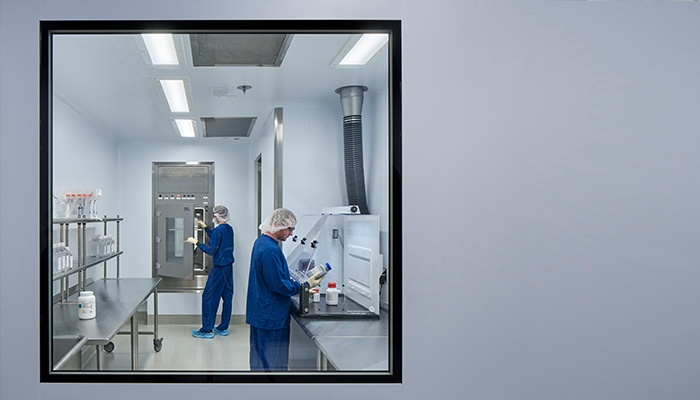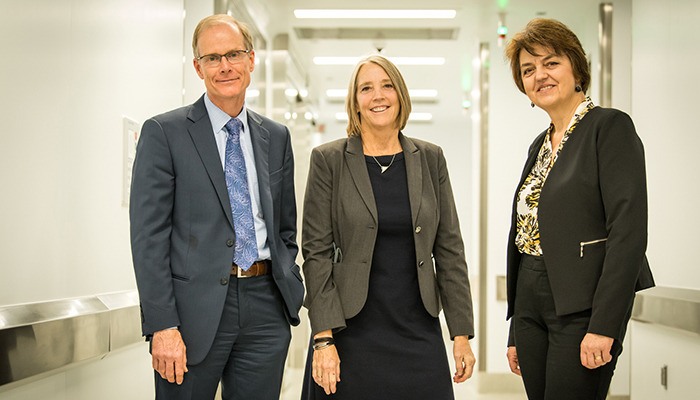HOW CAN WE HELP YOU? Call 1-800-TRY-CHOP
In This Section
Building on Nature's Delivery System to Advance Gene Therapy

The Raymond G. Perelman Center for Cellular and Molecular Therapeutics is located within the center of the gene therapy activities of CHOP and the University of Pennsylvania. Photo by Halkin Mason Photography.
Editor's Note: Where Discovery Leads is a multimedia storytelling project that delves into key research themes at CHOP Research Institute. In this story, we celebrate the Raymond G. Perelman Center for Cellular and Molecular Therapeutics. It was awarded the 2021 Facility of the Year Honorable Mention Award from the International Society for Pharmaceutical Engineering for its state-of-the-art clinical vector manufacturing facility, the Clinical Vector Core. The video below is courtesy of Ballinger, architect and engineer of the project.
mccannn [at] chop.edu (By Nancy McCann)
Looking at the human DNA over billions of years, we've learned that approximately 8 percent of it is derived from viruses that deposited genetic information into our genome — an efficient delivery method, to say the least. Today, in the burgeoning field of gene therapy, scientists are building on nature's genius.
Instead of delivering its harmful payload, viruses are modified to function as viral vectors that are able to deliver genetic code into cells to fix or replace mutations and defects in the target cells. Ultimately, this delivery system could be used to treat and potentially cure debilitating genetic diseases and disorders, including cancer, sickle cell disease, and blindness.
"In nature, viruses have transferred genetic information since the beginning of time," said Johannes van der Loo, PhD, director of the Clinical Vector Core in the Raymond G. Perelman Center for Cellular and Molecular Therapeutics (CCMT) at Children's Hospital of Philadelphia. "Virus-based transfer of genetic information is a system that nature has perfected, and now we're using these viruses as a delivery tool to transfer genetic information into cells."
The CCMT established the state-of-the-art Clinical Vector Core as a Current Good Manufacturing Practices (cGMP) facility for adeno-associated virus (AAV) and lentiviral vectors, under the leadership of Beverly Davidson, PhD, chief scientific strategy officer of CHOP Research Institute. In recognition of its innovation and creativity in facility design, construction, and application of technologies and cutting-edge approaches, the Clinical Vector Core received the 2021 Facility of the Year Award Honorable Mention from the International Society for Pharmaceutical Engineering (ISPE).
While now CHOP manufactures its viral vectors in this brand-new facility, the Clinical Vector Core has been manufacturing viral vectors for more than 15 years and has built an impressive track record that is internationally recognized. To date, more than 500 patients have been treated in 27 clinical trials at 75 study sites in 10 countries, including vectors that were crucial to the success of recent medical milestones — the first-ever gene therapies approved by the U.S. Food and Drug Administration. Collaborating with Penn Medicine scientists, CHOP experts produced the first vectors for CAR T-cell therapy to treat leukemias, as well as vectors that supported the development and approval of Luxturna™, a product used to treat a form of inherited blindness.

Manufacturing a viral vector is a custom process, as no two products are truly identical. Photo by Halkin Mason Photography.
Viral Vectors 101
By design, viral vector particles lack the viral genes necessary for viral replication, and generally only carry the gene of interest and genetic information needed to treat the genetic defect in a patient. As a result, exposure of cells to the virus leads to the transfer of information but does not cause an infection.
AAV vectors are based on AAV, a virus usually associated with the common cold. When cells are treated with AAV, the genetic information generally does not integrate into the cell's chromosomes. Scientists use this strategy to target tissues that contain cells that do not divide, such as for the treatment of the retina or the brain.
"AAV is a preferred vector to treat cells that do not divide because, as the cells divide, the message gets divided among the daughter cells and ultimately gets diluted and lost," Dr. van der Loo said. "At some point the daughter cells will no longer carry the information that was initially transferred."
On the other hand, the lentiviral vector is a vector that inserts the genetic information into the DNA of the target cell — into the chromosomes. When these cells divide, the new genetic information is copied along with the rest of the chromosomes.
"The daughter cells will have the exact same information as the parental cells," Dr. van der Loo said. "For instance, blood diseases can be treated by treating bone marrow stem cells with an integrating viral vector that carries the gene of interest; as a result, all bone marrow-derived blood cells will carry the revised genetic code."
State-of-the-Art Facility Earns Industry Recognition
The ISPE judging panel selected CCMT because of its impact on the future of cell and gene therapy facilities, noting, "the opportunity to merge cutting-edge medical treatment, integrated facilities, and technology in both an urban setting and close to the point of treatment were indicative of facilities of the future, and the CCMT breaks the typical mold."
Working in collaboration with architects and engineers since 2015, the 13,000-square-foot facility was completed in 2018 and is housed on CHOP's Philadelphia Campus. The location takes advantage of the cost effectiveness of existing hospital infrastructure, providing engineering support, building maintenance, security, and utilities. But ultimately, the main benefit of being on campus is that the facility is located within the center of the gene therapy activities of CHOP and the University of Pennsylvania.
"There is a tremendous advantage to be close to the various investigators involved in gene therapy," said Dr. van der Loo, an expert in preclinical and clinical vector production and characterization, "and for them to be able to walk over and sit down with us on-site to talk about their projects, project requirements, and clinical trials."

From left to right: Han van der Loo, PhD; Beverly Davidson, PhD; and Olga Zelenaia, PhD. Photo by Halkin Mason Photography.
Dedicated and Passionate Team 'Invested in Helping Patients'
The Clinical Vector Core works mostly with investigators who conduct Phase 1 and 2 clinical trials. Products are manufactured for investigators at CHOP and Penn as well as for clients in academia, government, and industry. By incorporating optimized workflows and a higher level of efficiency, the Clinical Vector Core is working to bring down the two-year backlog that has developed over the past years.
In order to support these early phase studies, the products manufactured need to be affordable, completed within a relatively short timeframe, and offer flexibility — all of which require quality control and quality assurance. All facility systems, manufacturing equipment, and aseptic fill and finish operations, must be compliant with cGMP. Pre-clinical work, including pharmacology and toxicology studies, are supported by offering products manufactured using a GMP-comparable process.
"Design of standardized manufacturing and quality processes and procedures compliant with cGMP and, at the same time, flexible enough to accommodate the uncertainties typical for early stage of pre-clinical and clinical development of the investigational drug, is extremely challenging but makes our work exciting and meaningful," said Olga Zelenaia, PhD, the Clinical Vector Core's director of quality.
Manufacturing a viral vector is a custom process, as no two products are truly identical. It's not a "cookie cutter process," according to Dr. van der Loo, and the benefit of being a small group is having the ability to be flexible and adaptable and having the ability to modify details of the procedure for each product as necessary.
"We're invested in helping patients," Dr. van der Loo said. "The fact that we have been able to support many successful clinical trials has given us a solid reputation in the field. And now that we have built a new state-of-the-art, multi-product GMP manufacturing facility, we will be able to even better support the growing field of gene therapy, locally, nationally, and internationally."


